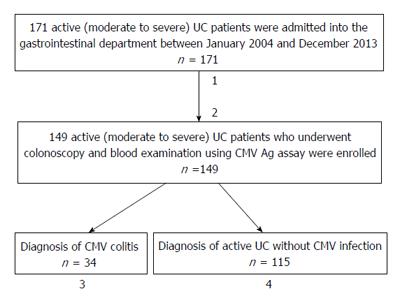Copyright
©The Author(s) 2016.
World J Gastrointest Endosc. Mar 25, 2016; 8(6): 301-309
Published online Mar 25, 2016. doi: 10.4253/wjge.v8.i6.301
Published online Mar 25, 2016. doi: 10.4253/wjge.v8.i6.301
Figure 1 Clinical course of cytomegalovirus-associated colitis in patients with moderate to severe ulcerative colitis.
Flow chart of the 171 patients admitted to our department with active UC. 1Seven patients with a history of CMV-associated colitis or anti-CMV treatment were excluded; 2Fifteen patients who had not undergone colonoscopy and examination using the CMV antigenemia assay were also excluded; 3Out of 34 UC patients with CMV-associated colitis, 26 received GCV antiviral therapy. After GCV therapy, 13 patients achieved remission, but 13 required colectomy. Eight patients did not receive GCV antiviral therapy, 4 of whom underwent colectomy; 4The remaining 115 UC patients not diagnosed with CMV-associated colitis received treatment for active UC, of which 81 achieved remission. Of the remaining patients, some improved but did not fulfill remission criteria, while others required a second treatment, hospitalization, or colectomy. CMV: Cytomegalovirus; UC: Ulcerative colitis; Ag: Antigenemia; GCV: Ganciclovir.
Figure 2 Endoscopic images of cytomegalovirus-associated colitis in patients with active ulcerative colitis.
A-C: Deep ulcer; D-G: Punched-out ulcer; H-J: Geographical ulcer; K: Longitudinal ulcer; L: Mucosal defect.
- Citation: Hirayama Y, Ando T, Hirooka Y, Watanabe O, Miyahara R, Nakamura M, Yamamura T, Goto H. Characteristic endoscopic findings and risk factors for cytomegalovirus-associated colitis in patients with active ulcerative colitis. World J Gastrointest Endosc 2016; 8(6): 301-309
- URL: https://www.wjgnet.com/1948-5190/full/v8/i6/301.htm
- DOI: https://dx.doi.org/10.4253/wjge.v8.i6.301










